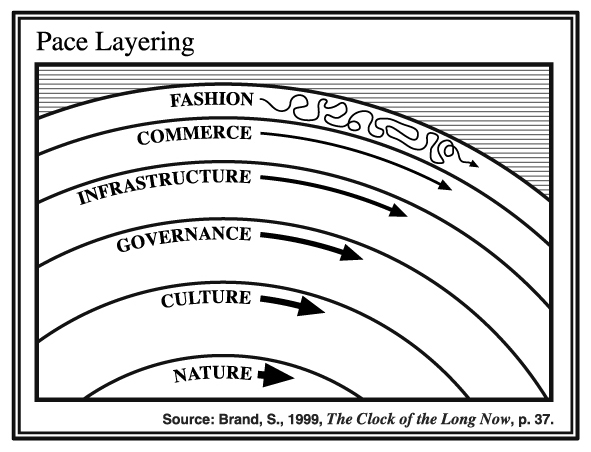 The order of civilization. The whole combines learning with continuity.
The order of civilization. The whole combines learning with continuity.
Coined by Stewart Brand in 1999.
See: Mangrove Theory of the Internet, Cross-time-scale planning (Bentoism)
You can’t have a healthy forest of all old-growth and towering canopies. You can’t have a healthy forest of only weeds, bushes, and saplings.
All complex systems have different ‘paces’ at which they operate. Some near the top are faster changing, learning with the trends and the movements of the day to day, others are slow and methodical, remembering and holding power.
The six Pace Layer levels in descending order from the highest & fastest to the lowest & slowest are Fashion, Commerce, Infrastructure, Governance, Culture, Nature.
Working down from the fast and attention-getting to the slow and powerful… Note that as people get older, their interests tend to migrate to the slower parts of the continuum. Culture is invisible to adolescents but a matter of great concern to elders. Adolescents are obsessed with fashion while elders are bored by it.
Physics (and trust) as a new pace layer
Proposing a layer even below nature: physics. This are the axioms of the universe that seem unchanging (at least in the real world) but are actually configurable in the digital. (see: Lattice)
Trust is enabled through consistent accessibility
- You can’t trust if you don’t know if something will be available
- Thus blockchain is a means of enabling trust, re: trusting objects and Extended Mind Hypothesis
- physics has infinite availability
- legitimacy is a pattern of higher order acceptance (vitalik)
- blockchains as digital physics (the bottom layer of trust)
Internet Pace Layering
The pace layering is partial—evolved layering is relaxed layering—but we can definitely see chronological shearing reflected by the cycle times of different layers of the stack. Hardware and programming languages tend to evolve on the decades timescale. Operating systems tend to release every few years. Apps, every month. Content is instant.